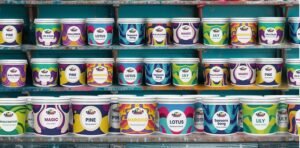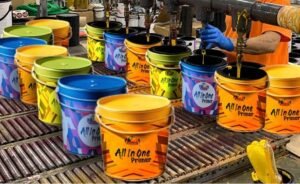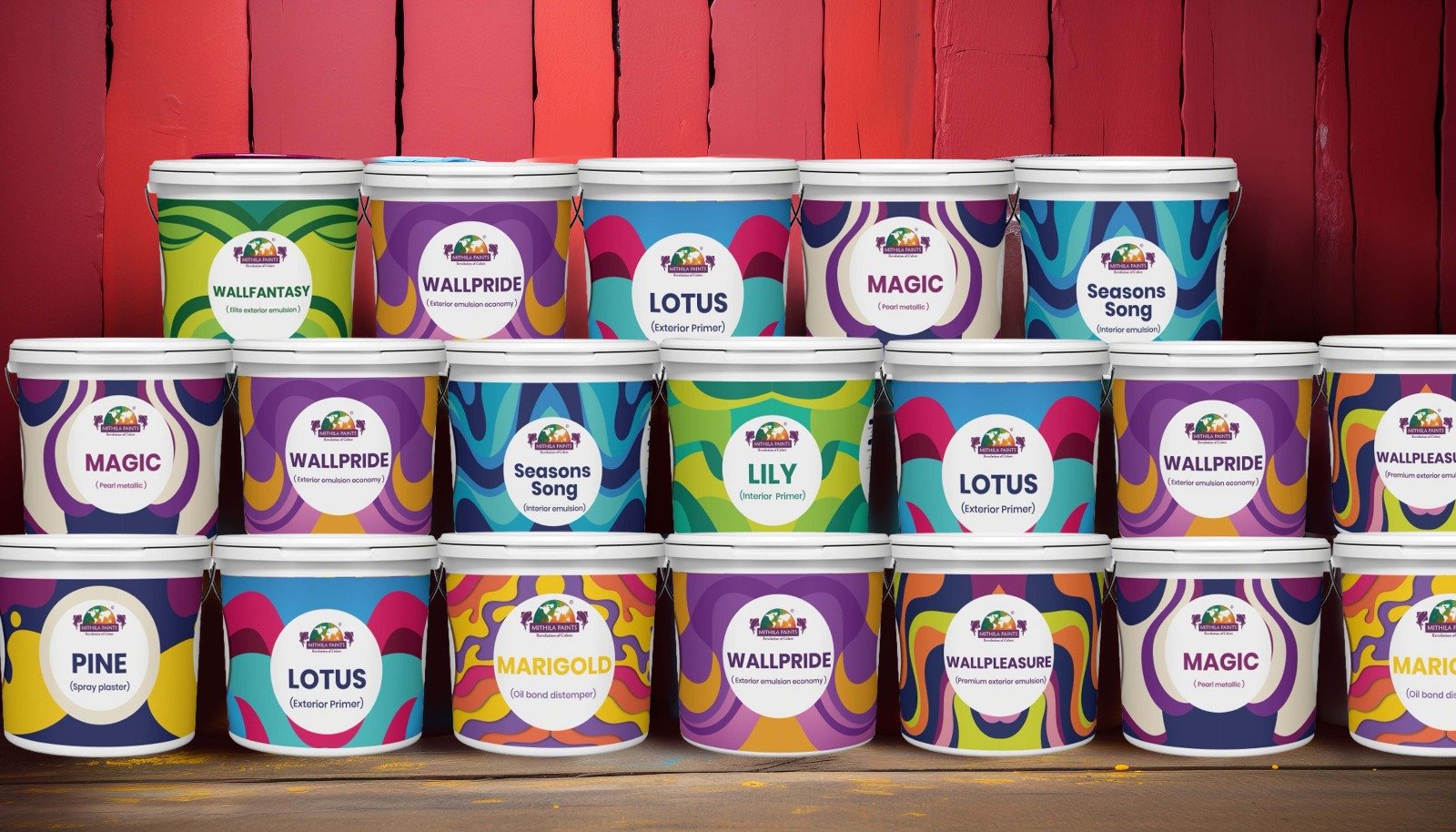Introduction to the Paint Exporters in India
Mithila Paints, a growing name in India’s paint export market, is known for its high-quality, eco-friendly, and regionally inspired products. Specializing in decorative paints, the company has a strong focus on producing affordable yet premium paints that cater to both domestic and international markets. Drawing inspiration from traditional Mithila art, the company emphasizes aesthetic appeal along with durability in its products. Mithila Paints has steadily expanded its reach, exporting to various countries across Asia, Africa, and the Middle East. Their commitment to innovation, quality, and customer satisfaction has helped them build a reputation in the competitive Indian paint export industry.
The paint industry in India has witnessed remarkable growth over the past few decades, emerging as one of the fastest-growing sectors within the manufacturing domain. With a compound annual growth rate (CAGR) projected to exceed 12% in the coming years, the industry is poised for significant advancements fueled by increased urbanization, rising disposable incomes, and evolving consumer preferences. Mithila paints, along with various other brands, have become synonymous with quality and innovation in the market, catering to diverse customer segments.
The Indian paint market is segmented into decorative and industrial paints, with decorative paints accounting for a substantial portion of overall sales. This trend underscores the increasing focus on aesthetic enhancement in residential and commercial spaces. Major market players, such as Asian Paints, Berger Paints, and Kansai Nerolac, have established a robust presence, offering a wide array of products that cater to both functional and decorative needs. Furthermore, the emergence of eco-friendly paint solutions has revolutionized consumer choices, highlighting the importance of sustainability in product development.
Another crucial aspect contributing to the industry’s growth is the strong demand for paint exports. International markets recognize the quality of Indian manufactured paints, resulting in a significant export volume that bolsters the economy. Factors such as competitive pricing, adherence to international quality standards, and innovative marketing strategies have reinforced India’s position as a prominent player in the global paint landscape. The export of mithila paints, characterized by unique designs and formulations, has further elevated India’s reputation within the international community.
The evolution of the paint industry in India has certainly positioned it as a vital contributor to the country’s economic framework. With ongoing advancements in technology and an ever-increasing emphasis on personalization and sustainability, the sector is set to achieve new milestones in the coming years.

Types of Paints Exported from India
India boasts a vibrant paint industry, contributing significantly to the global market with a diverse range of products. Among the various categories, decorative paints, industrial coatings, and specialty paints stand out due to their distinct characteristics and applications. Each category illustrates the versatility and innovation inherent in Indian paint manufacturing.
Decorative paints are one of the most prominent types exported from India, encompassing a variety of finishes such as emulsions, enamels, and distempers. These paints are primarily used in residential and commercial spaces, focusing on aesthetics and providing a protective layer to walls and surfaces. Mithila paints are particularly celebrated for their vibrant hues and cultural motifs, appealing to markets that value artisanal and handcrafted elements. The global demand for decorative paints remains strong, especially in regions experiencing urbanization and infrastructure development.
Industrial coatings form another critical segment of the Indian paint export market. These paints are designed to protect machinery, infrastructure, and other assets from corrosion, chemicals, and extreme environmental conditions. They play a crucial role in sectors such as automotive, manufacturing, and construction. The technical innovations in formulations have allowed Indian manufacturers to cater to various international standards, positioning them favorably in global markets. The emphasis on durability and performance in industrial coatings makes them an essential product for exporters.
Lastly, specialty paints encompass a wide array of products designed for specific applications, such as anti-fungal, anti-bacterial, or heat-resistant coatings. These paints cater to niche markets and are often tailored to meet unique requirements of various industries, including healthcare, aerospace, and food processing. The ability to customize formulations in response to market needs showcases the advanced technical capabilities of India’s paint exporters.


Overall, the multifaceted types of paints exported from India not only highlight the industry’s innovation but also reinforce its growing presence in the global market.
Export Process for Paint Manufacturers
Exporting paints from India involves a structured process, which ensures compliance with international standards and smooth delivery to overseas markets. The first step for paint manufacturers is to understand the regulations set by the importing country regarding mithila paints and other paint products. This often involves aligning with specific safety and quality standards that govern chemical compositions and environmental considerations.
Once the compliance requirements are clear, manufacturers must prepare the necessary documentation. This includes obtaining a registration certificate, which is crucial for export eligibility. Additionally, manufacturers need to generate relevant invoices, packing lists, and certificates of origin, which detail the shipment’s contents and prove the origin of the goods. The accuracy of these documents is essential as they facilitate customs clearance at the destination country.
Logistics plays a critical role in the export process of mithila paints. Selecting the right mode of transportation—whether by sea, air, or road—depends on the specifics of the shipment and the destination’s accessibility. Companies often partner with freight forwarders who specialize in the transportation of goods internationally. These professionals not only handle shipping logistics but also assist in managing complex procedures that encompass booking cargo space, navigating regulatory requirements, and optimizing shipping routes.
Customs agents are equally vital in this landscape, serving as intermediaries to ensure compliance with customs regulations of both the exporting and importing countries. They help in the clearance process by verifying the correctness of the documentation, calculating tariffs, and ensuring that all applicable duties are paid. Thus, their expertise can significantly expedite the transaction, minimizing the risks of delays and additional costs. Overall, a thorough understanding of the export process enhances the chances of success for paint manufacturers aiming to penetrate global markets.

Quality Standards and Certification Requirements
In the competitive landscape of paint exports, particularly for products like mithila paints, adherence to quality standards and certifications is paramount. Exporters must navigate a complex web of international regulations to ensure their products meet the necessary criteria for acceptance in global markets. Among the most recognized standards are the International Organization for Standardization (ISO) certifications, which provide a framework for quality management, assuring customers of a product’s reliability and consistency.
For example, ISO 9001 emphasizes quality management systems that must be implemented by companies involved in the production of mithila paints. Another important aspect is compliance with standards set by the American Society for Testing and Materials (ASTM), which outlines various tests related to paint performance, durability, and safety. ASTM standards ensure that the products can withstand varying environmental conditions, which is crucial considering the diverse climates in which these paints might be used.
Furthermore, environmental regulations play an increasingly vital role in the export of paints. With a growing global emphasis on sustainability, exporters must comply with regulations like the Environmental Protection Agency (EPA) standards or the Registration, Evaluation, Authorisation and Restriction of Chemicals (REACH) in Europe. These guidelines mandate strict adherence to safe chemical practices, significantly impacting formulations used in mithila paints. Companies must consistently innovate and accurately describe their materials to meet these regulations, which fortifies their position in international markets.
In conclusion, to remain competitive and ensure successful export of mithila paints and other variants, manufacturers must prioritize compliance with quality standards and certifications. This ensures not only market access but also fosters trust and assurance with clients across borders.

Challenges Faced by Paint Exporters in India
The paint export industry in India encounters a myriad of challenges that obstruct its potential growth and profitability. One of the foremost issues is compliance with regulatory requirements. Paint exporters must navigate a complex landscape of domestic and international regulations, which can vary significantly across countries. This often includes stringent safety and environmental standards related to chemical composition and labeling, making it essential for exporters to invest time and resources in understanding these legal frameworks. Failure to comply can result in financial penalties or the rejection of products in foreign markets.
Quality assurance also poses a significant hurdle for paint exporters. The demand for high-quality paints that meet international standards is ever-increasing. Exporters must implement rigorous quality control processes to ensure their products, including mithila paints and their variants, satisfy these global benchmarks. This necessitates investment in quality testing laboratories and adherence to industry certifications, which can be both time-consuming and costly for small to medium-sized enterprises.
Moreover, the competitive landscape in the paint industry is intensifying. Paint exporters in India face competition not only from domestic players but also from established international brands. Differentiating their product offerings, particularly in artistic categories like mithila paints, requires innovative marketing strategies and a focus on unique selling propositions. As these exporters seek to expand their market presence, they must harness effective branding and promotion to stand out.
Logistical issues also compound the difficulties faced by paint exporters. The challenges of shipping, transport, and managing supply chains can significantly affect delivery timelines and operational efficiency. With paints being sensitive to temperature fluctuations and handling, exporting firms must develop robust logistics strategies to mitigate risks and ensure product integrity during transit.
By acknowledging these challenges and leveraging insights from industry experts, paint exporters can develop strategies to overcome barriers, ultimately enhancing their competitiveness in the global marketplace.
Emerging Markets for Indian Paint Exports
The Indian paint industry has been witnessing significant growth over the last few years, with various factors contributing to the emerging markets for Indian paint exports. As economies around the world continue to evolve, certain countries and regions have shown promising potential for boosting demand for products, including mithila paints and other decorative coatings. This section delves into the key markets that are ripe for exploration and expansion in the realm of Indian paint exports.
One of the primary regions exhibiting substantial growth is Southeast Asia. Countries like Vietnam, Indonesia, and the Philippines are experiencing rapid urbanization and economic development. The construction sector in these nations is burgeoning, leading to an increased requirement for decorative paints, including those inspired by traditional motifs like mithila art. This surge in activity presents a lucrative opportunity for Indian paint exporters to tap into these expanding markets with tailored offerings.
Another area gaining attention is the Middle East. With nations like the United Arab Emirates and Saudi Arabia investing heavily in infrastructure and housing projects, the demand for quality paints is on the rise. Here, Indian paint manufacturers can leverage their expertise in both contemporary and traditional designs, such as mithila-inspired patterns, to cater to the unique tastes of consumers in these markets. The preference for environment-friendly and innovative coating solutions is a growing trend in the region, making it crucial for exporters to adapt their products accordingly.
Additionally, African nations, particularly Nigeria and South Africa, are experiencing a construction boom driven by population growth and a rising middle class. These markets are becoming increasingly receptive to various paint products, including Indian decorative paints. By recognizing and responding to the diverse cultural influences in these regions, Indian paint exporters can further broaden their reach and capitalize on the escalating demand for decorative finishes.
Sustainable Practices in Paint Exporting
The paint industry in India has witnessed a significant transformation in recent years, particularly in the realm of sustainability. As global awareness regarding environmental issues escalates, Indian paint exporters are increasingly adopting eco-friendly practices in production and formulation. These sustainable practices are not only vital for environmental conservation but also align with the growing consumer demand for greener, safer products.
One of the primary initiatives embraced by paint exporters is the development of mithila paints that utilize natural, non-toxic ingredients. This shift has led to the creation of water-based and low-VOC (volatile organic compounds) paints, which significantly reduce harmful emissions compared to conventional solvent-based alternatives. By utilizing these eco-friendly formulas, exporters are able to cater to a market that prioritizes health and ecological responsibility. Additionally, many companies are exploring plant-based binders and organic pigments, thus minimizing their carbon footprint.
Furthermore, sustainable practices extend beyond paint formulation to encompass the entire production process. Many paint manufacturers have invested in energy-efficient technologies and waste reduction strategies to minimize environmental impact. This includes optimizing energy consumption during manufacturing, ensuring that waste materials are properly recycled, and implementing water conservation techniques. These initiatives not only enhance production efficiency but also meet stringent international standards that favor sustainable exports.
As a response to the evolving market dynamics, the demand for sustainable options is influencing the export strategies of Indian paint manufacturers. They are increasingly positioning their products in international markets by highlighting their eco-friendly attributes. This alignment with global sustainability objectives is essential for maintaining competitiveness and gaining access to countries that prioritize environmental consciousness in their import policies. The concerted efforts made by exporters to adopt sustainable practices ultimately contribute to a more responsible and environmentally friendly paint industry.
The Future of Paint Exports from India
The future of paint exports from India appears promising, buoyed by a combination of technological advancements, shifting consumer trends, and evolving global trade policies. As the market for decorative and industrial paints expands, Indian manufacturers, including those specializing in unique offerings such as mithila paints, are increasingly positioning themselves on the international stage.
One significant factor influencing this positive outlook is the rise of advanced manufacturing technologies. Automation and artificial intelligence are revolutionizing production processes, resulting in enhanced efficiency and quality. The capability to produce specialized products such as eco-friendly and sustainable paints is gaining traction, aligning with global consumer demand for greener solutions. Mithila paints, characterized by their distinct artistic patterns, can benefit from these innovations, allowing creators to expand their reach beyond traditional markets.
Consumer preferences are continually evolving, particularly as awareness of environmental issues grows. There is a notable increase in demand for paints that are both high-quality and sustainable. This trend presents an opportunity for Indian exporters to innovate and integrate more eco-friendly practices into their product lines, which includes exploring the rich tradition of mithila paints. By marrying tradition with modern environmental considerations, Indian producers can not only appeal to domestic consumers but can also tap into international markets that prioritize sustainability.
Moreover, potential changes in trade policies can significantly impact the export landscape. India’s participation in various trade agreements may reduce tariffs and open new avenues for market access. Experts project that a proactive approach to trade negotiations could fortify India’s position as a leading paint exporter. With a focus on marketing unique products like mithila paints, Indian exporters have the potential to carve out robust niches in the global market.

In conclusion, the future of paint exports from India hinges on its ability to adapt to technological changes, align with consumer preferences, and navigate shifting trade policies effectively. By leveraging these factors, the industry is poised for substantial growth, making it an exciting era for paint manufacturers.
